Construction projects require managing specific components, such as materials, employees, project deadlines, and client expectations. With the right construction project management software, you can more easily complete these tasks while collaborating with your team members.
In this product guide, I evaluate nine of the best construction project management software options. I’ve taken a close look at their costs, features, and pros and cons to help you determine the best software for your team.
Top construction project management software comparison
When choosing the best construction management software for your business, you need to consider pricing as well as features. This table shows a comparison of cost and functionality for my top software picks.
| Scheduling | Bid management | Mobile app | Client portal | Starting price | |
|---|---|---|---|---|---|
| Fieldwire | Yes | Yes | Yes | No | $54 per month |
| Contractor Foreman | Yes | Yes | Yes | Yes | $79 per month |
| Jira | Yes | No | Yes | Yes | $8.15 per month |
| Confluence | Yes | No | Yes | Yes | $6.05 per month |
| Buildertrend | Yes | Yes | Yes | Yes | $499 per month |
| Houzz Pro | Yes | No | Yes | Yes | $85 per month |
| Procore | Yes | Yes | Yes | No | Contact sales for pricing |
| monday | Yes | No | Yes | Yes | $9 per user per month |
| Sage | Yes | Yes | Yes | Yes | Contact sales for pricing |
Fieldwire: Best overall for construction project management

Fieldwire is purpose-built construction project management software designed for general contractors, specialty contractors, owners, architects and designers. It offers functionality to help plan, manage, and track construction-specific projects from start to finish, providing the necessary features for successful project delivery.
Fieldwire lets users connect with their teams in real time while interacting with project tasks, uploading documents, and sharing photos. Its capabilities also include task management, checklists, punch lists, inspections, and reports.
Fieldwire pricing
- Basic: This is a free plan with a limit of five users and three projects.
- Pro: $39 per user per month when billed annually, or $54 per user when billed monthly.
- Business: $59 per user per month when billed annually, or $74 per user when billed monthly.
- Business Plus: $79 per user per month when billed annually, or $94 per user when billed monthly.
- Enterprise: Contact the Fieldwire sales team for custom quotes.
Fieldwire feature spotlight
- Supports real-time communication among teams for accelerated decision-making.
- Includes team performance tracking to ensure timely task delivery.
- Allows users to manage upcoming items with customizable PDF reports that can be scheduled.
- Includes all-inclusive features for various types of contractors, including concrete, electrical, plumbing, HVAC, interior finishing, and fire-stopping contractors.
- Offers platform support for 19 languages; the customer support team is fluent in English, French, Spanish, Portuguese, German, Czech, and Italian.
- Supports kanban boards, Gantt charts and calendar views.
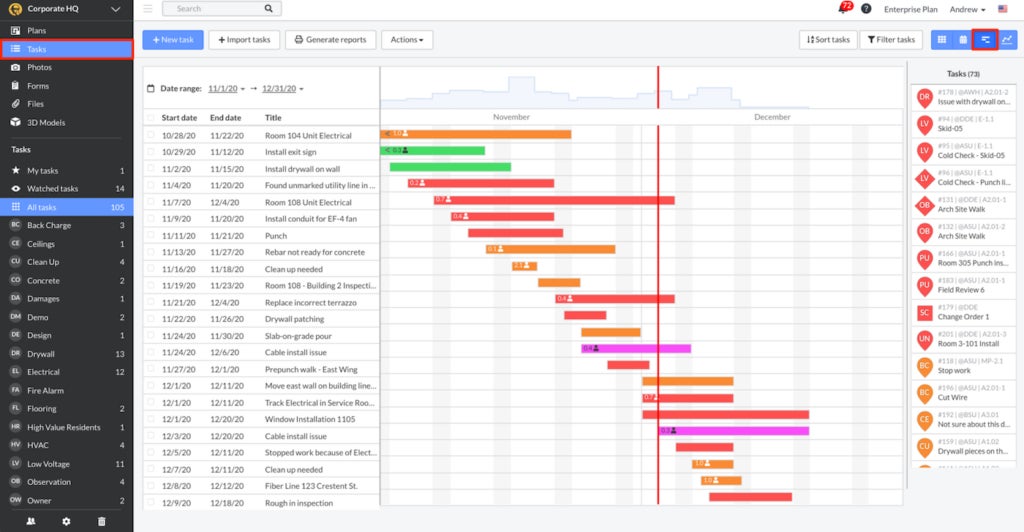
Fieldwire top integrations
- Dropbox.
- Google Drive.
- SharePoint.
- OneDrive.
Fieldwire pros and cons
| Pros | Cons |
|---|---|
| Transparent pricing. | Basic and Pro plans lack phone support. |
| Free plan available for budget-conscious users. | API access limited to the Enterprise plan. |
| File sharing and plan viewing. | Free trial must be requested. |
| Multi-device support for Web, Android, iOS. | Basic plan is limited to five users. |
| Real-time push notifications. | Limited customization for smaller contractors. |
| Custom form creation. | Onboarding can be time-consuming. |
Why I chose Fieldwire
Fieldwire was my best overall pick for its real-time communication and custom reporting features, as well as the high level of customization available. I found Fieldwire to be an effective project management solution specifically-designed for construction as it offers a wealth of features for contractors, plumbers, HVAC, and more. In my hands-on trial of the software, its detailed task management and inspection features allowed me to stay on top of every detail, which showed me it would manage complex construction projects with ease.
Contractor Foreman: Best for ease of use

Contractor Foreman is easy-to-use, intuitive, and user-friendly cloud-based construction project management software. It helps contractors and subcontractors manage their entire project life cycle, from estimating and bidding to project scheduling and job costing.
Contractor Foreman offers a 30-day free trial and flat annual pricing options for a limited number of users. Although Contractor Foreman offers four pricing plans, the lower-tier plans include the core features most teams will need to manage their projects.
Contractor Foreman pricing
- Basic: $49 per month, billed annually.
- Standard: $79 per month when billed annually, or $99 per month when billed quarterly.
- Plus: $125 per month when billed annually, or $155 per month when billed quarterly.
- Pro: $166 per month when billed annually, or $212 per month when billed quarterly.
- Unlimited: $249 per month when billed annually, or $312 per month when billed quarterly.
Contractor Foreman feature spotlight
- Allows users to run an unlimited number of projects.
- Includes daily logs of complete project records, weather tracking and material and equipment used.
- Allows electronic approvals and signatures.
- Supports Gantt charts.
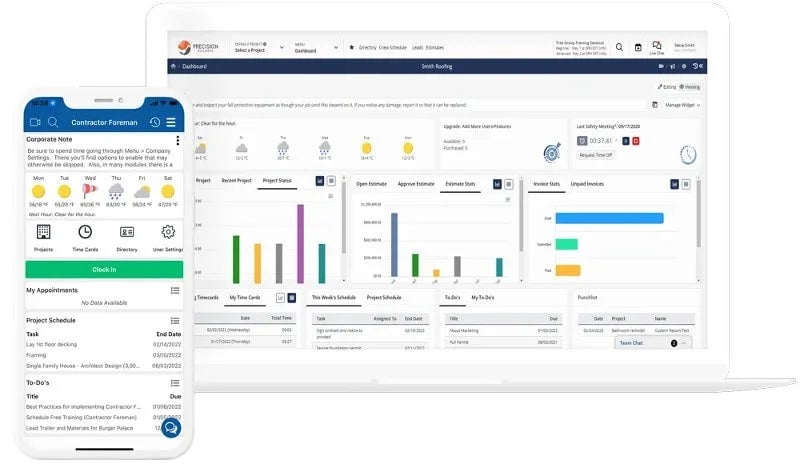
Contractor Foreman top integrations
- Google Calendar.
- Gusto.
- QuickBooks.
- SweetPay.
- Zapier.
Contractor Foreman pros and cons
| Pros | Cons |
|---|---|
| 30-day free trial available. | Standard plan lacks client portals. |
| 100-day money-back guarantee. | Somewhat limited integrations. |
| Easy-to-use and intuitive user interface. | Training on how the modules integrate could be improved. |
| Designed with the needs of contractors in mind. | User interface can feel outdated. |
Why I chose Contractor Foreman
I found Contractor Foreman to be a tool that teams with several construction projects to manage would want to use, as it offered me the freedom to have an unlimited number of projects. It has a straightforward user interface that allows you to easily incorporate the software into your existing workflows.
Jira: Best for task tracking
TechRepublic Rating: 4.6/5

Jira is an issue-tracking and project management tool for anywhere from one user to teams of 20,000+ people that is based on agile project management methodology. The versatile software has a multitude of features and customizable templates that allow users to create their own specialized workflows. With features such as project roadmaps, team collaboration, time tracking, budgeting, document management, and analytics reports, Jira keeps teams on track throughout the project life cycle.
In addition, Jira’s Gantt charts come with smart resource risk management add-ons, which can be useful for managing and reallocating project resources when unexpected variables like weather impact project outcomes and schedules.
Jira pricing
- Free: $0 for up to 10 users.
- Standard: $8.15 per user per month, billed monthly for up to 100 users.
- Premium: $16 per user per month, billed monthly for up to 100 users.
- Enterprise: This plan is quote-based.
Jira feature spotlight
- Reports and insights capabilities.
- Customizable workflows.
- Workflow management with scrum and kanban boards.
- Project roadmap capability, which enables users to define their project goal and vision.
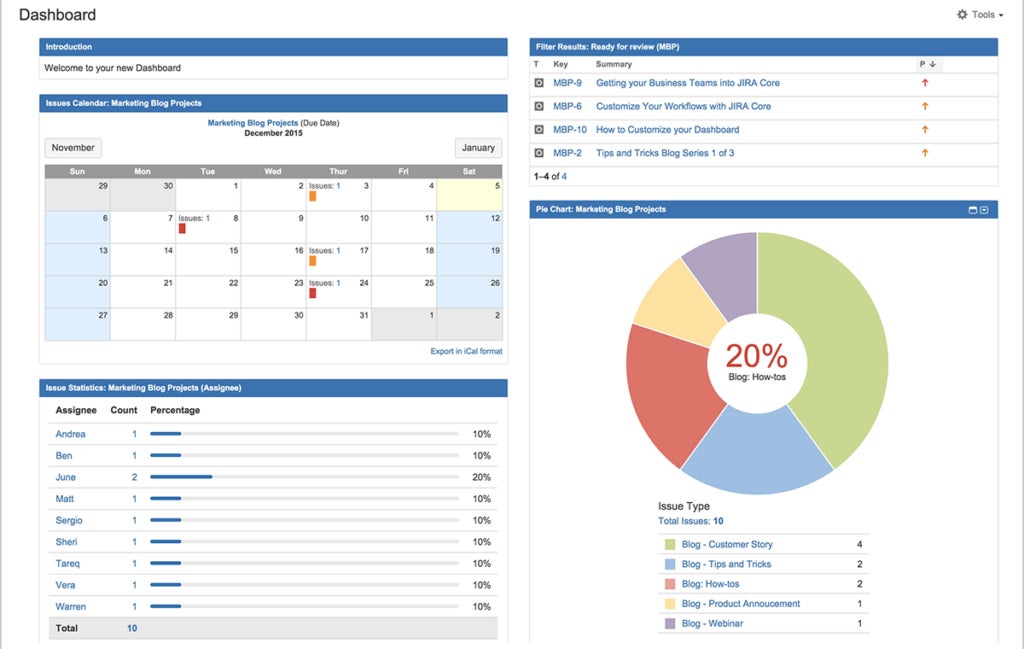
Jira top integrations
- Dropbox.
- Slack.
- Microsoft Teams.
Jira pros and cons
| Pros | Cons |
|---|---|
| Integration with over 3,000 apps. | Complex initial setup process. |
| Drag-and-drop automation. | Primarily built for engineering and software development teams, not construction. |
| Easy to use and highly customizable. | Interface can feel cluttered at times. |
Why I chose Jira
I added Jira to my shortlist for its thorough task tracking and project visualization features. Its functionality is based on the agile project management methodology, which makes it competent for tracking complex workflows, and the drag-and-drop interface simplifies the management of tasks and timelines. I also appreciate its scalability, which I feel is suited to managing both small and large teams effectively while keeping an eye on project progress with detailed reporting.
Although Jira is not specifically designed for construction teams, it offers many features that are helpful for this kind of work. For example, Jira’s hierarchical and Gantt chart elements are ideal for managing more granular and even unplanned administrative project tasks that may arise, such as filing change orders.
For more information, read the full Jira review.
Confluence: Best for collaboration
TechRepublic Rating: 4.5/5

Confluence is team collaboration software that helps teams organize and share information, collaborate, plan, and track projects from one centralized location. It can be used for a variety of project management needs, including task management, resource management, project timelines, and project reporting.
It is used by both small and large teams and can be customized to fit their differing needs. Whether it’s a worker on a construction site or a back-office team member who manages payroll in another country, each team member can view the company’s feed and find answers to their questions on their own time.
Confluence pricing
- Free: $0 for up to 10 users.
- Standard: $6.05 per user per month, billed monthly for up to 100 users.
- Premium: $11.55 per user per month, billed monthly for up to 100 users.
- Enterprise: This plan is quote-based.
Confluence feature spotlight
- Library of project management templates, including end-of-week status reports and Atlassian project plans.
- Marketing campaign templates for planning and tracking marketing tasks and deadlines.
- 99.9% and 99.95% uptime service-level agreements are available in Premium and Enterprise tier plans, respectively.
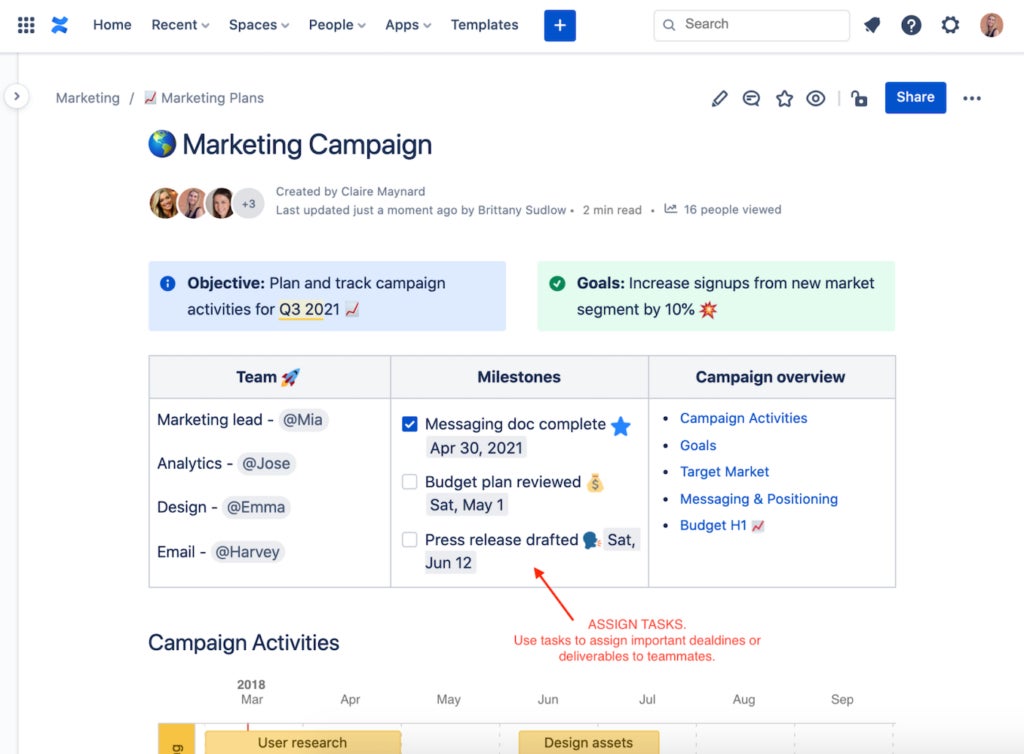
Confluence top integrations
- Jira.
- Trello.
- Figma.
- Slack.
- Google Drive.
- Microsoft Teams.
Confluence pros and cons
| Pros | Cons |
|---|---|
| Free plan available. | Free and Standard plans have limited support. |
| Mobile app for iOS and Android. | Can be expensive for organizations with large numbers of users. |
| Designed for optimized team collaboration. | Not specifically designed for construction work. |
Why I chose Confluence
I found Confluence to be appealing due to its document collaboration and knowledge management features. I can see how the ability to centralize project documentation and access and edit materials in real-time would be beneficial to contractors working across multiple job sites. Its range of templates streamlines the documentation process, helping maintain consistency across projects. Plus it integrates with other Atlassian tools, such as Jira.
Confluence isn’t specifically designed for construction projects, but it’s especially great for construction companies with several offices or distributed workforces. The platform allows administrators to create collaborative knowledge hubs for sharing the most up-to-date company and team news, not to mention the project spaces and searchable labels users can add to their accounts.
For more information, read the full Confluence review.
Buildertrend: Best for remodelers
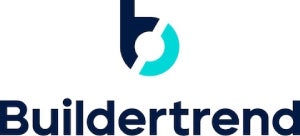
Buildertrend is cloud-based construction project management software designed for home builders, specialty contractors, remodelers, and commercial contractors. They can use this software to schedule tasks, track progress, manage budgets, keep documents organized, and access job site information.
Buildertrend’s project management software integrates with many popular business apps, such as QuickBooks, Xero, and Gusto for payroll and accounting services. It also integrates with the Home Depot Pro Xtra program for purchasing needs.
Buildertrend pricing
- Essential: $199 for the first month, then $449 per month if billed annually or $499 per month billed monthly.
- Advanced: $499 for the first month, then $719 per month if billed annually or $799 per month billed monthly.
- Complete: $799 for the first month, then $989 per month if billed annually or $1,099 per month billed monthly.
Buildertrend feature spotlight
- Advanced estimate and bid management.
- Ability for users to create requests for information and add photos or documents to the platform.
- Lead management and proposal capabilities.
- Time clock features, which enable teams to clock in and out on their phones.
- Invoice creation based on estimates.
- File annotation capabilities.
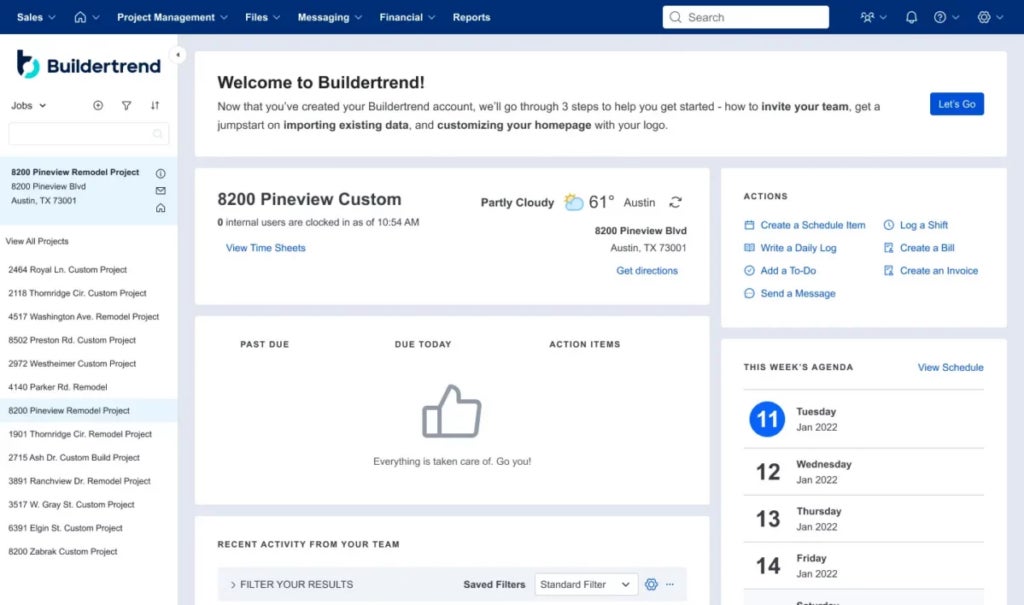
Buildertrend top integrations
Buildertrend pros and cons
| Pros | Cons |
|---|---|
| Offers transparent pricing. | Steep learning curve. |
| Automates email campaigns and tracks lead responses. | Lack of a free trial option or a forever-free plan. |
| Offers a customer portal. | Expensive pricing plans may cost too much for some small businesses. |
| Bills management. | Limited estimating features. |
| Boasts an A+ rating from Better Business Bureau. | Limited integrations with non-construction applications. |
Why I chose Buildertrend
I found Buildertrend’s client and contractor portal made real-time collaboration more seamless. It provides the power to track projects in progress while also taking advantage of the various project management tools the software has to offer.
Beyond its integrations and primary feature set, Buildertrend also offers a customer portal that allows clients and subcontractors to collaborate on and discuss project progress.
For more information, check out our full Buildertrend review.
Houzz Pro: Best for lead generation

Houzz Pro is a business platform for industry professionals, including home remodelers, interior designers, architects, landscape professionals and other building professionals. It connects professionals with customers, provides marketing and networking tools and offers insights into the home improvement industry. It also offers resources for business growth, including advertising, lead management and analytics.
Houzz Pro pricing
- Starter: $85 per user per month.
- Essential: $129 per user per month.
- Pro: $199 per user per month.
- Advertising Package: From $499 per month for unlimited users.
- Custom: Contact for quote.
Houzz Pro feature spotlight
- Lead generation program.
- Built-in solutions for email marketing, custom website development, and targeted advertising.
- 3D floor planner.
- Integrated customer relationship management capabilities.
- Time tracking capabilities.
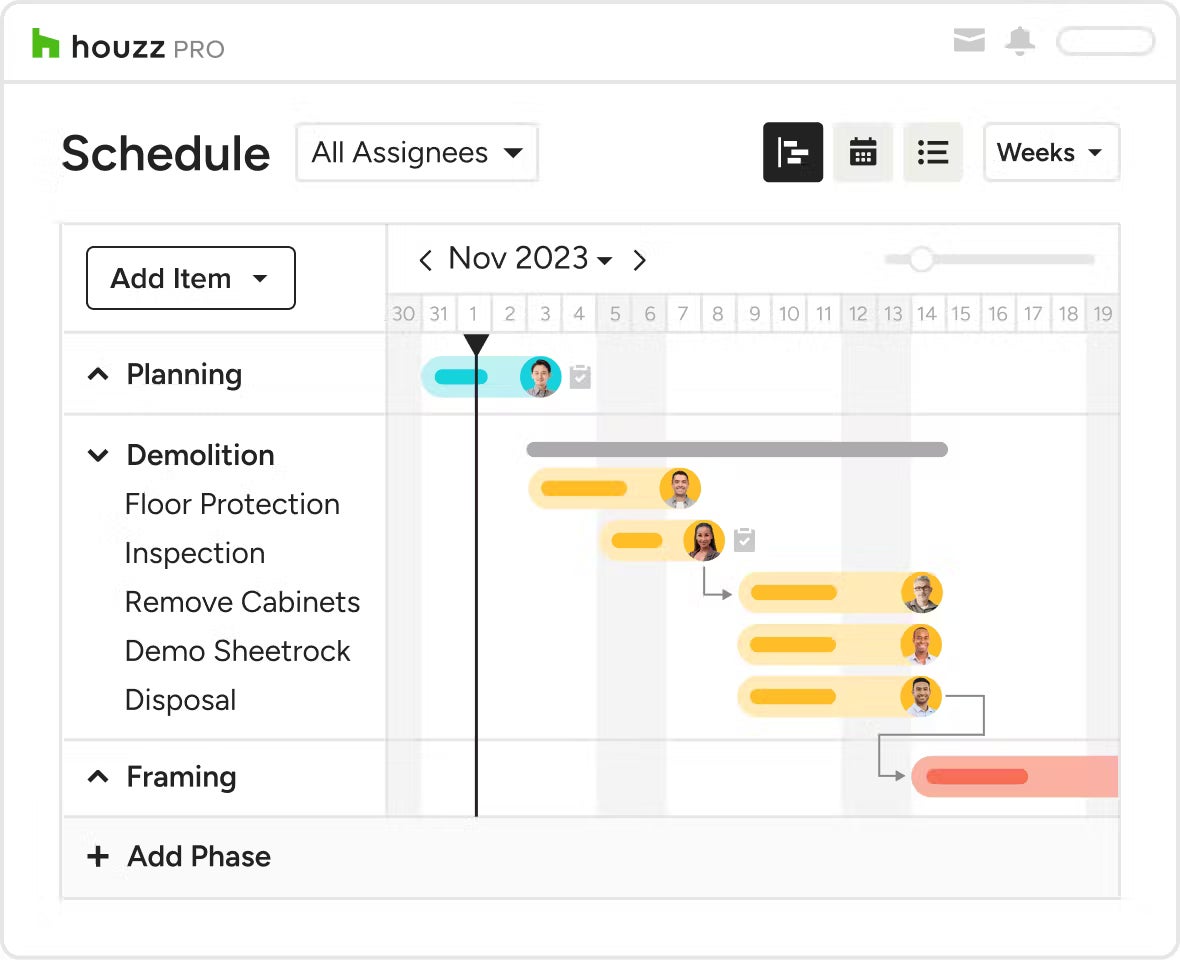
Houzz Pro top integrations
- QuickBooks.
- Google Calendar.
- Microsoft 365.
- Sales Layer.
Houzz Pro pros and cons
| Pros | Cons |
|---|---|
| 30-day free trial available for all plans. | Limited support for lower-tier plans. |
| Mobile app for iOS and Android. | Can get expensive quickly. |
| Integration with Intuit QuickBooks. | Messages to potential clients sometimes get caught in spam. |
| Augmented reality walkthrough feature. | Lacks advanced project management features. |
Why I chose Houzz Pro
The varied lead generation tools were the feature that attracted me to Houzz Pro as a solution for construction project management. I came across capabilities from targeted local advertising to a concierge team to connect users with homeowners by phone, cutting across a variety of construction trades including interior design, painting, masonry, plumbing, roofing, and so much more.
Procore: Best for technical support

Procore is cloud-based construction project management software for general contractors, specialty contractors, subcontractors, owners, developers, and government agencies. Construction professionals can use the tool to manage projects from pre-construction through closeout, including document management, budgeting, scheduling, RFIs, submittals, quality and safety, field productivity management and collaboration.
Procore pricing
Procore doesn’t advertise rates on its website. Potential buyers should contact the Procore sales team for pricing information.
Procore feature spotlight
- Provides real-time visibility into project financial health.
- Includes intelligent specification management.
- Allows for unlimited storage.
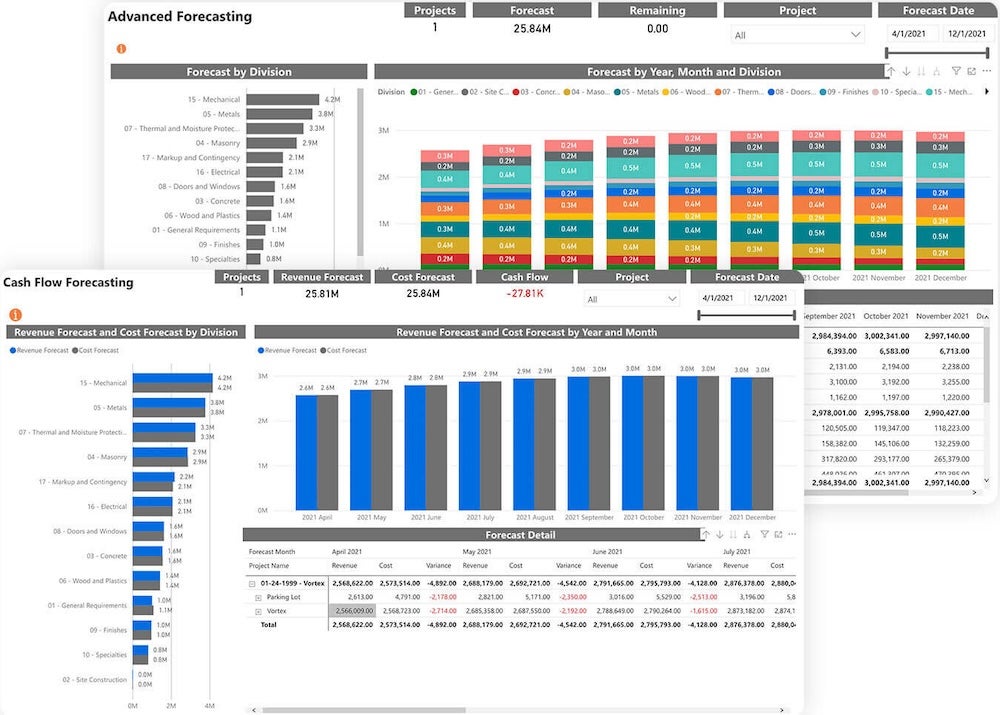
Procore top integrations
- DocuSign.
- Criterion HCM.
- 360 Sync.
- AkitaBox.
- Hiboo.
Procore pros and cons
| Pros | Cons |
|---|---|
| Unlimited storage for documents and project data. | Lack of transparent pricing. |
| Mobile app available for iOS and Android. | Limited scalability. |
| Active community forum with over 40,000 members. | High learning curve due to the extensive features. |
Why I chose Procore
Procore presented me with a variety of technical support options, starting with self-service support cutting across web, mobile, windows, integrations, and portfolio financials. These options are quite in-depth without ever feeling overwhelming as there are drop-down lists to pinpoint the project tools and company tools I need assistance with. If these options don’t address your issue, then Procore offers phone, email, and live chat as support options. However, the phone support option isn’t 24/7.
monday.com feature spotlight
- Customizable workflows for managing project phases and tasks.
- Visual project tracking with Gantt charts and calendars.
- Budget and expense tracking templates to manage financial limits.
- Mobile access for on-site project management and updates.
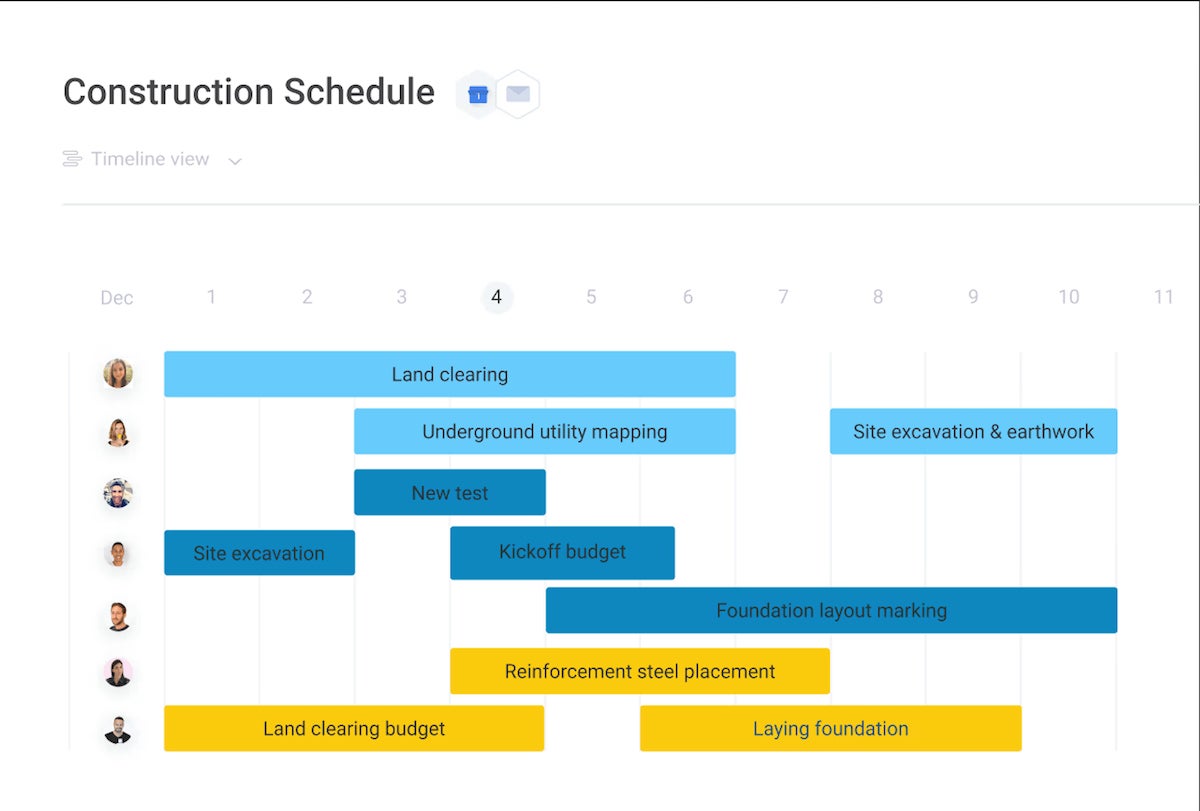
monday.com top integrations
- QuickBooks.
- Google Drive.
- Slack.
- Zapier.
monday.com pros and cons
| Pros | Cons |
|---|---|
| Customizable workflows fit for construction. | Not a construction-focused tool. |
| Visual project tracking with Gantt charts. | Some users report a learning curve for setup. |
| Integration with financial tools like QuickBooks. | Only a handful of construction templates available. |
Why I chose monday.com
Although it’s not a construction project management tool by default, monday.com’s strength is its all-in-one nature. It delivers a highly customizable platform that can be adapted to manage construction projects, covering stakeholders like project owners, planners, general contractors, and specialty contractors. monday.com also provides a few templates for a few construction use cases, which meant that I didn’t have to set up projects from scratch.
For more information, read the full monday.com review.
Sage: Best for accounting and financial management
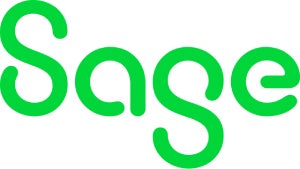
Sage is a powerful solution that provides construction-specific financial and project management tools. It’s best suited for small to midsize contractors who need help managing budgets, payroll, and job costing. Sage is known for its extensive accounting capabilities as it offers advanced tools for managing complex financial aspects of construction projects.
Sage pricing
Sage doesn’t present its pricing information upfront. Prospective users need to request pricing from Sage.
Sage feature spotlight
- Accounting and job costing tools to manage budgets and project financials.
- 2D and 3D estimating for more accurate project planning.
- Cloud-based project management for easy access from any location.
- Document management for storing and sharing project-related files.
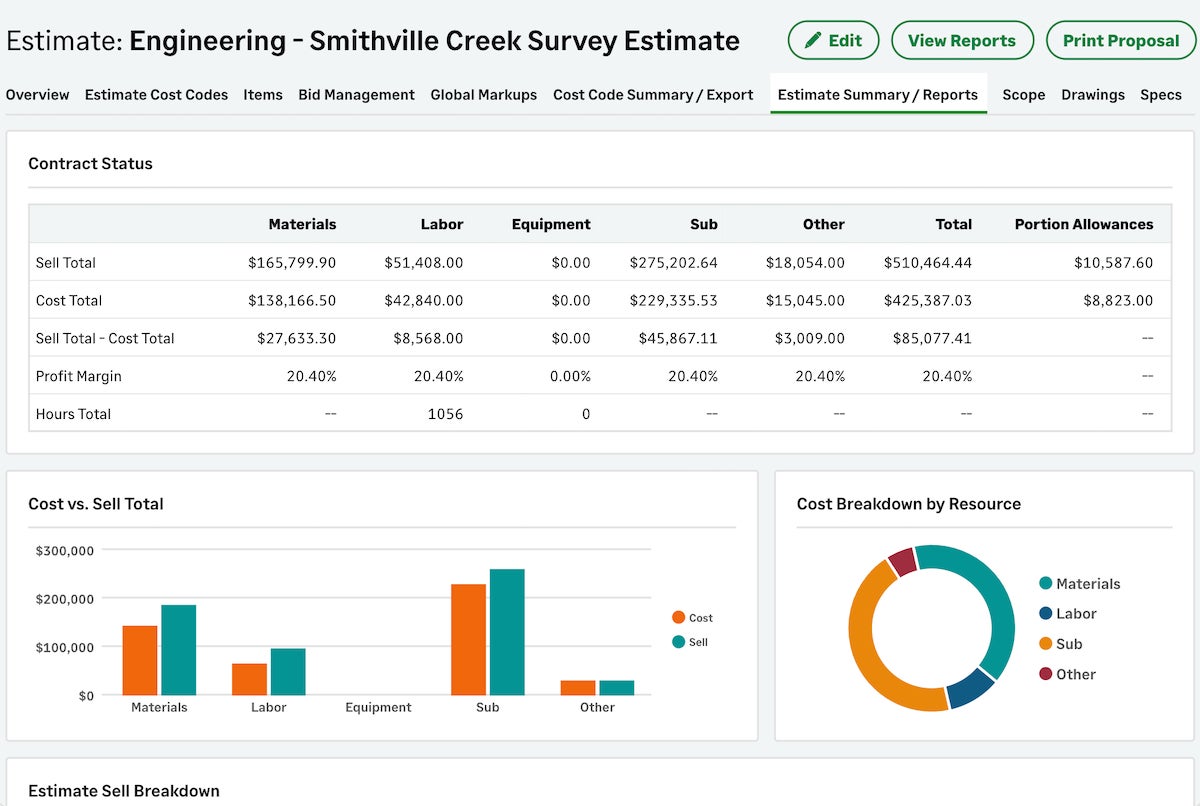
Sage top integrations
- QuickBooks.
- Sage Intacct Construction.
- Sage 100 Contractor.
- Sage 300 CRE.
Sage pros and cons
| Pros | Cons |
|---|---|
| Advanced accounting features for construction projects. | Complex setup and steep learning curve. |
| Integration with estimating and payroll systems. | No upfront pricing. |
| Ideal for small to midsize contractors. | Customer support has room for improvement. |
Why I chose Sage
I included Sage in my list because of its selection of financial management features for construction companies. I could keep track of job costing, payroll, and project budgets in real time, which helps prevent overruns and ensures projects stay within scope. The integration with 2D and 3D estimating tools also gives teams an accurate way to plan resources and manage project costs effectively.
For more on Sage, read our full Sage 100 Contractor review.
Key features of construction project management software
Software for construction project management needs to combine general-purpose project management features with construction-specific capabilities. Here are eight features that you should look out for when comparing software for construction management:
Time tracking and scheduling
The best construction project management software should let you schedule workers for shifts and track billable hours worked, all within the tool itself. Some may also offer integrations with popular time tracking and scheduling software in case you already have a solution in place.
Estimate and bid management
Your team will likely be submitting bids on multiple projects at once, as well as receiving estimates from subcontractors. These are sometimes called RFIs, a.k.a. requests for information. Construction project management software will allow you to track these bids and their associated costs to reduce the chance of miscalculations and ensure that you’re staying on top of deadlines.
Accounting and financial management
Once the project gets going, you will also need to track inventory costs, invoice the client and make sure the project is staying within budget. The best construction management software will let you do all that and more with sophisticated accounting and financial management tools. It should also integrate with popular accounting software, such as QuickBooks.
Field management
Keeping track of all your workers across various job sites is one of the most important features of construction-specific software. This involves booking service appointments, coordinating dispatch and setting estimated completion dates. If you are considering a more general-purpose project management software, make sure that it will provide the field management capabilities that you need for your construction projects.
Mobile and tablet apps
On the topic of field management, most people aren’t logging into their laptops in the middle of a job site. That’s why you will want to seek out software that offers well-developed mobile and tablet apps so your managers and employees can use them while on location.
Client and contractor access
At some point during the project, clients and/or contractors are going to need to access the software — but you might not want them to see every single detail. Being able to set permissions for different users is a helpful feature for construction project management software to have. Some platforms even offer a dedicated client portal, so they get their own login experience.
Communication tools
To keep everything streamlined in one tool, look for construction management software that integrates chat and communication tools directly within the interface. Ideally, it should also integrate with popular email clients like Outlook and Gmail so that your email communications will be centralized in the same place.
Document management
If your construction management software offers document management capabilities, you’ll never need to hunt down an updated contract or the latest certificates and licenses. All of these documents will be right in the tool’s database, easily accessible via search so you can find it in a snap.
How do I choose the best construction project management software for my business?
When selecting a construction project management software solution, consider your needs, goals and budget. Take an account of the scope of your projects, such as how many people are involved and how complex the tasks for the project may be. Look into various solutions, experiment with software that offers free trials and get feedback on what works best for you and your team.
Beyond the software itself, consider what integrations are available to better refine it. With the right integrations along with software that fits your team and project workflow, you can find a comprehensive solution for your construction work.
Frequently asked questions (FAQs)
What is construction project management software?
Construction project management software is a solution that helps contractors, project managers, and teams manage every phase of a construction project, from planning and scheduling to budgeting, tracking, and collaboration. It offers features like task management, budget tracking, document sharing, and team communication.
What is the best construction project management software?
The best construction project management software will vary depending on your construction project needs. However, Fieldwire proves to be quite well-rounded, with extensive tools for managing tasks, communication, and project tracking.
Jira excels at task tracking, Buildertrend is well-suited for remodelers with its client management features, Procore has top-notch technical support, and Sage is a good pick for construction-specific financial management tools.
How do I choose construction project management software?
When choosing construction project management software, consider the size of your company, project complexity, and the key features that your workflows need. Look for software that offers task management, budgeting tools, team collaboration features, and integrations with your existing systems. Assess how easy it is to use, its support services, and whether it’s capable of scaling well with your business.
Methodology
To determine the best construction project management software, I evaluated several solutions from leading providers. This evaluation was done by comparing the pricing, design, and features of each software. After my comparisons, I narrowed the list to what I felt were the best software based on their overall strengths and weaknesses.

